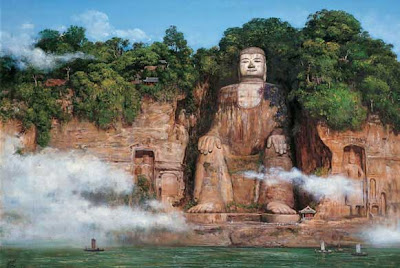The Giant Buddha of Leshan
 The Giant Buddha of Leshan is the tallest stone Buddha statue in the world, carved out of a cliff face by an 8th-century monk in southern Szechuan province. The Giant Buddha overlooks the confluence of the Minjiang, Dadu and Qingyi rivers and faces the sacred Mount Emei (with which it shares its World Heritage status).
The Giant Buddha of Leshan is the tallest stone Buddha statue in the world, carved out of a cliff face by an 8th-century monk in southern Szechuan province. The Giant Buddha overlooks the confluence of the Minjiang, Dadu and Qingyi rivers and faces the sacred Mount Emei (with which it shares its World Heritage status).According to a local saying: "The mountain is a Buddha and the Buddha is a mountain."
Known as Dafo, the statue depicts a seated Maitreya Buddha with his hands resting on his knees, gazing across the river with heavy-lidded eyes. Maitreya is the future Buddha, who will appear to preach the dharma when the teachings of Gautama Buddha have faded away. He was especially popular during the 4th to 7th centuries and his images can be found throughout the Buddhist world, conveying his characteristic air of expectancy and promise.
History

Construction on the Giant Buddha began in 713 AD. It was the idea of a Chinese monk named Haitong, who hoped that the Buddha would calm the turbulent forces that plagued the shipping vessels travelling down the river. It was said there was a river monster that lived at this spot. He often caused floods that capsized passing boats and took cost many lives. In order to subdue the waters and save lives, Master Haitong, a Buddhist abbot of the Lingyun Monastery, raised the necessary funds and commenced the construction of the Giant Buddha.
He hoped that the presence of the Great Buddha would subdue the monster and so pacify the swift currents thereby protecting the boatmen who traversed the treacherous river. His plans were not just supernatural - the enormous amount of rubble carved away from the cliff would be deposited in the river, altering the currents and calming the waters. The construction project was continued by his disciples and finally completed by the local governor in 803.
 On December 6th, 1996, Leshan Giant Buddha was approved by the UNESCO as the Heritage of World Culture and Nature and was officially inscribed on the World Heritage List. The comment of the Committee of World Heritage was as follows: "During the first century A. D., Mount Emei in Sichuan province became one of Buddhism's holiest sites. Over the centuries, the cultural treasures grew in number. The most remarkable is the Giant Buddha of Leshan, carved out of a hillside in the 8th century. At 71 m high, it is the largest Buddha in the world."
On December 6th, 1996, Leshan Giant Buddha was approved by the UNESCO as the Heritage of World Culture and Nature and was officially inscribed on the World Heritage List. The comment of the Committee of World Heritage was as follows: "During the first century A. D., Mount Emei in Sichuan province became one of Buddhism's holiest sites. Over the centuries, the cultural treasures grew in number. The most remarkable is the Giant Buddha of Leshan, carved out of a hillside in the 8th century. At 71 m high, it is the largest Buddha in the world."Giant Buddha Temple
As high as the mountain is the statue pavilion, Whose hand placed the steps leading forward? Day and night the fog is rising and setting, And the dews on the mountain are teasing. Clear is the moon waiting to be touched, While faint is the sun where doves go to inhabit. Also drafted to the boundless frontier, The bonfire implied the suffering of the common people.
-Xue Neng
At the right back of the giant Buddha's head stands the Lingyun Temple, from which the details on the giant Buddha's head can be observed. Called Baoen Temple in ancient times, the Lingyun Temple is also referred to as Giant Buddha Temple. The construction of the Lingyun Temple began in the Tianbao Period of the Tang Dynasty, well before that of the Giant Buddha. The original temple was destroyed, and the present one was rebuilt in the early years of the Qing Dynasty.
In addition to the Leshan Giant Buddha, there are numerous famous sites located in the scenic spot in which the Leshan Giant Buddha is located including: Mt. Lingyun, Wuyou Hill, Guicheng Hill, Moruo Hall, Qianfeng Cave, and the sleeping Giant Buddha. There are many Han Dynasty cliff tombs, where many mortuary artifacts have been found making this area particularily important for archaeologists.




Comments
I know you love those 17 cosmic triggers...
so...
Happy Nov. 17th!
- JH
“Maitreya is a bodhisattva who in the Buddhist tradition is to appear on Earth, achieve complete enlightenment, and teach the pure dharma. According to scriptures, Maitreya will be a successor of the historic Śākyamuni Buddha, the founder of Buddhism. The prophecy of the arrival of Maitreya is found in the canonical literature of all Buddhist sects (Theravāda, Mahāyāna, Vajrayāna) and is accepted by most Buddhists as a statement about an actual event that will take place in the distant future”.
The similarity of the Judaistic concept of a redeemer messiah and the second coming of the christos figure within Christianity emerge from the prophetic tradition, which relies on a future event for fulfillment. This seems to be a universal concept (within humanity), as many cultures share this mythos.